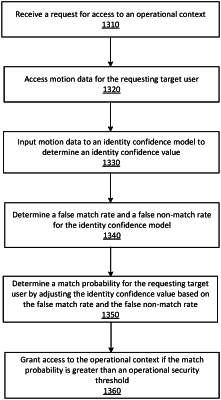| CPC G06F 21/32 (2013.01) [G06F 18/22 (2023.01); G06N 20/00 (2019.01); G06V 40/40 (2022.01); H04L 63/08 (2013.01); H04L 63/108 (2013.01); H04L 63/1433 (2013.01); G06F 18/2415 (2023.01)] | 19 Claims |

|
1. A non-transitory computer-readable medium comprising stored computer-readable instructions that, when executed by a processor, cause the processor to execute instructions comprised to:
receive a request from a requesting target user for access to an operational context,
characteristic data describing actions of the requesting target user, wherein the characteristic data is collected from a source during a period of time and the request comprises authentication credentials representing an authenticating identity;
for an identity confidence model,
input the characteristic data to the identity confidence model to determine an identity confidence value, wherein the identity confidence model is trained to process characteristic data collected by the source and the identity confidence value describes a likelihood that an identity of the requesting target user matches the authenticating identity based on collected characteristic data;
determine a false match rate and a false non-match rate based on characteristic data collected during a preceding period of time, wherein the false match rate and the false non-match rate represent a performance of the identity confidence model; and
determine a decayed false match rate and a decayed false non-match rate for the identity confidence model based on a decay parameter, the false match rate, the false non-match rate, and an amount of time elapsed;
update the match probability based on the decayed false match rate and the decayed false non-match rate;
determine a match probability for the requesting target user by adjusting the identity confidence value determined by the identity confidence model based on the decayed false match rate and decayed false non-match rate, wherein the match probability represents a likelihood that the identity of the requesting target user matches the authenticating identity;
and
grant the requesting target user access to the operational context responsive to determining the match probability is greater than an operational security threshold.
|